"Radio Control Tower"
Brad Snider's Home Page
I was first introduced to hiking in Pennsylvania. Then in Colorado I took up scrambling, rock-climbing, and the poorly-named “peak-bagging.” Wanting to expand my mountaineering horizons to some of North America’s bigger mountains, I decided to learn glacier travel and crevasse rescue. With little time or resources, however, I decided that signing up for a guided trip was the best way to begin. That is how I ended up in Alaska with American Alpine Institute, at Denali base camp on the Southeast Fork of the Kahiltna Glacier. Our group of ten (2 guides, 8 clients) set up camp in solitude on the hill above Denali base camp, completely surrounded by world-class scenery amidst some of North America’s most magnificent mountains. Denali rose behind us, the summit just visible above a col between Mount Frances and “Lisa’s Peak,” and the ever-impressive masses of Mount Foraker and Mount Hunter kept us Alaska newbies in awe for the duration of the trip. The 7-day Denali-prep course covered the basics of glacier travel, rope-work, sled-rigging and pulling, crevasse rescue, and wrapped up with ice climbing.
Day 6 was summit day. Our guides, Coley and Forest, had chosen Radio Control Tower for our miniature alpine climb. With its incredible surroundings, this mountain appears as a comparatively-small
trapezoidal rock face visible from base camp, but we would find out there is much more to this peak than first meets the eye.
We divided into 3 rope teams and began the approach to the northern snow slopes that would lend us access to the Control Tower. A huge crevasse field was evident even from camp, and we
stayed to the north of the worst of the crevasses as we began our ascent. I was the last person in the last rope team, so when we rounded a blind corner and came up onto a flat bench in the glacier, I was surprised to see Richard and Doug prostrate in self-arrest. The other end of the rope disappeared into a gaping hole in the snow, and Coley was peering down the hole as his rope team held taut.
Cameron, leader of the second rope team, had fallen 15-20 feet into a crevasse after breaking through a weak snow bridge that the first rope team had safely crossed. Cameron’s rope had cut back through the wide lip of the crevasse, but Richard and Doug stopped his fall as promptly as possible with their quick action.
Meanwhile, our rope team carefully crossed the snow bridge further down the crevasse, and Forest tied in with the first rope team to help pull. Coley had set up anchor near the hole, and lowered a C-pulley to Cameron. The team was busy pulling the rope, when suddenly
Brad fell into a separate crevasse, stopping his fall with both arms outstretched to either side of the hole. An avalanche rumbled down a vertical couloir on the face of Mount Frances directly across from us, and low clouds hung over us for the first time this week. This was beginning to feel ominous.
Our guides remained calm and kept the situation completely under control. Brad’s extraction was quite simple; he popped out of the hole as Team 1 continued to pull. Before long Cameron was safely above ground as well, with only a few words: “It was a cold and not-happy place down there.” His fall had cost him both water bottles and his hat, but thankfully he was okay. Understandably he had an adrenaline rush that would not go away for the rest of the day.
Extracting the pack and the rope from underneath the lip of the crevasse required some more work, but before long everyone was safely across both crevasses, and we were moving uphill again. Only half an hour had passed since Cameron first fell; now we continued up safer snow slopes toward the ridge.
We were the front rope team now, and I was surprised when we first stepped onto a snowy knife edge with sharp drops on both sides—our introduction to the mountain’s east ridge. We would stay on or near this ridge the rest of the way to the summit. The knife edge was short-lived, but the ridge continued to undulate in an interesting series of hills, each with unique characteristics.
One of the dips in the ridge contained another
obviously weak snow bridge over an unavoidable crevasse. Forest stepped across first, and Patrick caught himself on the opposite edge as he broke though to his waist. I glanced down the hole as I stepped across, and was unable to see the bottom. Below, Coley probed for a better way across, and everyone else made it without incident.
We all affixed crampons for
the final 45-degree slope to the summit. This was a fun, airy finish to an exciting climb. The clouds were pushing through now, allowing glimpses of the surrounding mountains; the views of the Alaska Range, especially Mount Hunter and Mount Foraker, were spectacular. We all sat on the summit for nearly two hours, enjoying the complete calm and the awesome scenery.
The
first half of the descent went quickly. This time, however, the guides decided it would be best to avoid our earlier “incident field” and instead make a run down the south side of the crevasses. There was some potential for avalanche from the overhanging seracs to the south, but we would spend little time there. Now on lead, I began plunge-stepping quickly down the slopes, enduring a sphincter-clenching ten minutes as I stepped across several more weakening snow-bridges.
The clouds had completely cleared and the warm sun radiated off the snow as we re-entered the flatter terrain of the Kahiltna Glacier. As we strode back to camp, I thought to myself how glad I was that I had signed up for this course. The guides were top-notch, the weather turned out to be great, and the ten of us formed one cohesive group, despite our very diverse backgrounds. The weather would sour upon our departure date, restricting us to base camp
for an extra day and a half. Though I was ready to return home by that point, this brief introduction convinced me that I will definitely return someday to the Alaska Range!
© 2008, Brad Snider, Brad Snider's Mountain Home Page




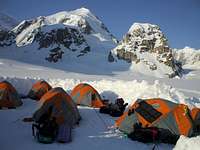

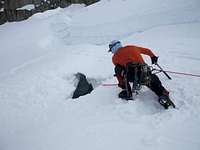
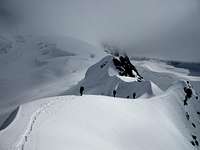
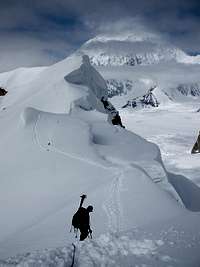
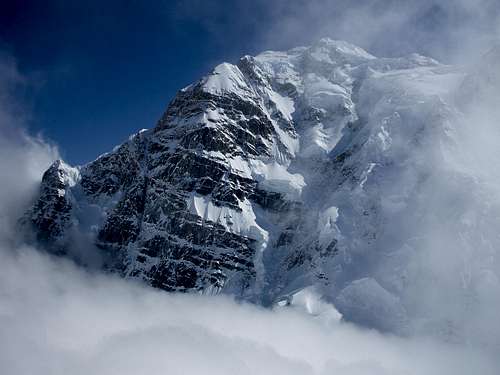





Comments
Post a Comment